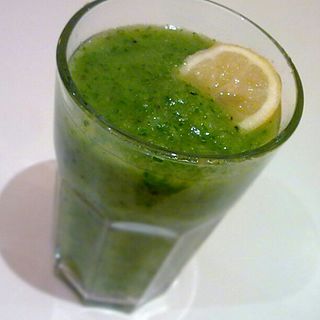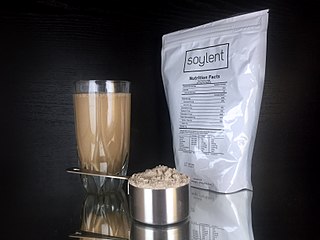Related Research Articles
Dieting is the practice of eating food in a regulated way to decrease, maintain, or increase body weight, or to prevent and treat diseases such as diabetes and obesity. As weight loss depends on calorie intake, different kinds of calorie-reduced diets, such as those emphasising particular macronutrients, have been shown to be no more effective than one another. As weight regain is common, diet success is best predicted by long-term adherence. Regardless, the outcome of a diet can vary widely depending on the individual.

The Atkins diet is a low-carbohydrate fad diet devised by Robert Atkins in the 1970s, marketed with claims that carbohydrate restriction is crucial to weight loss and that the diet offered "a high calorie way to stay thin forever".
Food energy is chemical energy that animals derive from their food to sustain their metabolism, including their muscular activity.

A fad diet is a diet that is popular, generally only for a short time, similar to fads in fashion, without being a standard scientific dietary recommendation, and often making unreasonable claims for fast weight loss or health improvements; as such is often considered a type of pseudoscientific diet. Fad diets are usually not supported by clinical research and their health recommendations are not peer-reviewed, thus they often make unsubstantiated statements about health and disease.

Low-carbohydrate diets restrict carbohydrate consumption relative to the average diet. Foods high in carbohydrates are limited, and replaced with foods containing a higher percentage of fat and protein, as well as low carbohydrate foods.

Cat food is food specifically designed for consumption by cats. As obligate carnivores, cats have specific requirements for their dietary nutrients, namely nutrients found only in meat, such as taurine, arginine, and Vitamin B6. Certain nutrients, including many vitamins and amino acids, are degraded by the temperatures, pressures and chemical treatments used during manufacture, and hence must be added after manufacture to avoid nutritional deficiency.
Body for Life (BFL) is a 12-week nutrition and exercise program, and also an annual physique transformation competition. The program utilizes a low-fat high-protein diet. It was created by Bill Phillips, a former competitive bodybuilder and previous owner of EAS, a manufacturer of nutritional supplements. It has been popularized by a bestselling book of the same name.

A healthy diet is a diet that maintains or improves overall health. A healthy diet provides the body with essential nutrition: fluid, macronutrients such as protein, micronutrients such as vitamins, and adequate fibre and food energy.

The Grapefruit diet is a short-term fad diet that has existed in the United States since at least the 1930s. There are variations on the diet, although it generally consists of eating one grapefruit at each meal, along with meat, eggs, other foods that are rich in fat and protein, and certain vegetables. Sugar, fruits, sweet vegetables, grains and starchy vegetables are to be avoided. The grapefruit diet is thus a low-carbohydrate diet. A typical breakfast menu usually includes bacon and eggs. The diet is based on the claim that grapefruit has a fat-burning enzyme or similar property. The grapefruit diet does not require exercise. The grapefruit diet lasts for 10 to 12 days followed by 2 days off.

A very-low-calorie diet (VLCD), also known as semistarvation diet and crash diet, is a type of diet with very or extremely low daily food energy consumption. VLCDs are defined as a diet of 800 kilocalories (3,300 kJ) per day or less. Modern medically supervised VLCDs use total meal replacements, with regulated formulations in Europe and Canada which contain the recommended daily requirements for vitamins, minerals, trace elements, fatty acids, protein and electrolyte balance. Carbohydrates may be entirely absent, or substituted for a portion of the protein; this choice has important metabolic effects. Medically supervised VLCDs have specific therapeutic applications for rapid weight loss, such as in morbid obesity or before a bariatric surgery, using formulated, nutritionally complete liquid meals containing 800 kilocalories or less per day for a maximum of 12 weeks.

Proteins are essential nutrients for the human body. They are one of the building blocks of body tissue and can also serve as a fuel source. As a fuel, proteins provide as much energy density as carbohydrates: 4 kcal per gram; in contrast, lipids provide 9 kcal per gram. The most important aspect and defining characteristic of protein from a nutritional standpoint is its amino acid composition.

Herman Taller was a Romanian-born American obstetrician who advocated weight loss based on a low-carbohydrate diet with polyunsaturated fats including safflower oil. He was the author of the controversial best selling book, Calories Don't Count which made false health claims.

The Western pattern diet is a modern dietary pattern that is generally characterized by high intakes of pre-packaged foods, refined grains, red meat, processed meat, high-sugar drinks, candy and sweets, fried foods, industrially produced animal products, butter and other high-fat dairy products, eggs, potatoes, corn, and low intakes of fruits, vegetables, whole grains, pasture-raised animal products, fish, nuts, and seeds.
A protein-sparing modified fast or PSMF diet is a type of a very-low-calorie diet with a high proportion of protein calories and simultaneous restriction of carbohydrate and fat. It includes a protein component, fluids, and vitamin and mineral supplementation.
The South Beach Diet is a popular fad diet developed by Arthur Agatston and promoted in a best-selling 2003 book. It emphasizes eating food with a low glycemic index, and categorizes carbohydrates and fats as "good" or "bad". Like other fad diets, it may have elements which are generally recognized as sensible, but it promises benefits not backed by supporting evidence or sound science.

Weight management refers to behaviors, techniques, and physiological processes that contribute to a person's ability to attain and maintain a healthy weight. Most weight management techniques encompass long-term lifestyle strategies that promote healthy eating and daily physical activity. Moreover, weight management involves developing meaningful ways to track weight over time and to identify ideal body weights for different individuals.

A meal replacement is a drink, bar, soup, etc. intended as a substitute for a solid food, usually with controlled quantities of calories and nutrients. Some drinks come in powdered form or pre-mixed health shakes that can be cheaper than solid foods with identical health qualities. Medically prescribed meal replacement drinks include the body's necessary vitamins and minerals. Bodybuilders sometimes use meal replacements, not formulated for weight loss, to save food preparation time when eating 5-6 meals a day.
Metrecal was a brand of low-calorie, powdered diet foods "containing the essential nutrients of protein, carbohydrate, fat, vitamins and minerals" introduced in the early 1960s by the Mead Johnson company, with the first variety going on the market on October 6, 1959, the same day as another Mead Johnson product, Enfamil. Though the initial Metrecal products were criticized for their taste, which newer varieties of flavor tried to improve upon, it attained a niche in the popular culture of the time. Created and marketed initially by C. Joseph Genster of Mead Johnson & Company, it was eventually replaced in the market by competitors such as SlimFast and lost popularity.

Protein Power is a high-protein, low carbohydrate fad diet developed by physician Michael R. Eades and his wife Mary Dan Eades.
References
- 1 2 3 4 5 6 The Gale Encyclopedia of Diets. Bukupedia. 2008. p. 152. ISBN 9781414429915.
- ↑ Brody, Jane E. (16 November 1983). "PERSONAL HEALTH". The New York Times. Retrieved 28 March 2021.
- ↑ Walsh, James (1998). You Can't Cheat an Honest Man: How Ponzi Schemes and Pyramid Frauds Work and why They're More Common Than Ever. Silver Lake Publishing. p. 188. ISBN 978-1-56343-169-2 . Retrieved 28 March 2021.
- ↑ "The 1:1 Diet - FAQs". The Cambridge Weight Plan. Retrieved 28 March 2021.
- ↑ "Business Opportunity Watch" . Retrieved November 16, 2023.
- ↑ "Dietician Describes Cambridge Diet as 'Wishful Thinking'". Los Angeles Times. 24 June 1982. Retrieved 18 February 2009.
- ↑ "Medical Researchers Urge Caution in Use of Cambridge Diet". The New York Times. 25 November 1983. Archived from the original on 2016-05-06. Retrieved 18 February 2009.
- 1 2 3 Thomas RJ (1995). New Product Success Stories: Lessons from Leading Innovators. John Wiley & Sons. p. 93. ISBN 978-0-471-01320-4.
- ↑ "Diet Firm Pays In Death Of Woman". Associated Press. 28 February 1985.
- ↑ Berg FM (1999). "Health Risks Associated With Weight Loss and Obesity Treatment Programs". Journal of Social Issues. 55 (2): 285. doi:10.1111/0022-4537.00116.
Deaths associated with VLCDs have been documented for more than 25 years. At least 58 people died from liquid protein diets in the 1970s, and six deaths were documented in the early 1980s from the Cambridge liquid diet
- ↑ Keen H, et al. (Committee on Medical Aspects of Food Policy – Working Group on Very Low Calorie Diets) (1987), Report on Health and Social Subjects 31: The Use of Very Low Calorie Diets in Obesity (PDF), HMSO
- 1 2 Porcello LA (1984). "A practical guide to fad diets". Clin Sports Med. 3 (3): 723–9. doi:10.1016/S0278-5919(20)31315-6. PMID 6571242.
- 1 2 Smith, Faye M.; Martin, Rachael (13 January 2021). "The Cambridge Diet Plan: how does it work and can it help you lose weight?". Woman and Home Magazine. Retrieved 28 March 2021.
- ↑ Webster-Gandy J, Madden A, Holdsworth M, eds. (2006). Oxford Handbook of Nutrition and Dietetics. Oxford University Press. p. 413. ISBN 0198567251.
- 1 2 "Fad Diets: What You Need to Know". familydoctor.org. American Academy of Family Physicians. 2005. Archived from the original on 2007-04-06. Retrieved 6 April 2007.
- ↑ "Top diets review". NHS UK. 26 April 2018. Archived from the original on 20 March 2019. Retrieved 26 July 2019.
A VLCD that involves eating 1,000 calories or fewer should not be followed for more than 12 continuous weeks. If you're eating fewer than 600 calories a day, you should have medical supervision.
- ↑ Isner JM, Sours HE, Paris AL, Ferrans VJ, Roberts WC (December 1979). "Sudden, unexpected death in avid dieters using the liquid-protein-modified-fast diet. Observations in 17 patients and the role of the prolonged QT interval". Circulation. 60 (6): 1401–12. doi: 10.1161/01.cir.60.6.1401 . PMID 498466.
- ↑ "What's the Plan". Cambridge Weight Plan. 15 April 2019. Archived from the original on 2019-04-15.